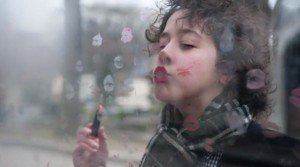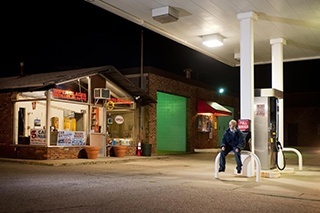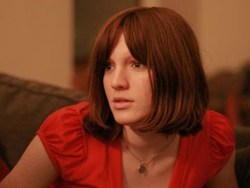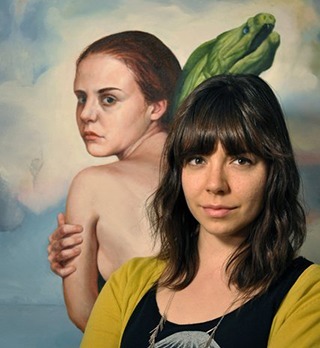Over at his blog Six Questions, Jim Harrington has been inviting editors to share their views on what they consider "good writing" (particularly when it comes to fiction). Our answers are on deck to appear on the site, but since we've just re-opened to submisssions, I thought I'd post them here too.
Thomas Dodson
Editor, Printer's Devil Review
SQF: What are the top three things you look for in a submission and why?
I trust my editors in poetry, nonfiction, and visual arts to select the best work from those sections. Jess Barnett, one of our arts editors, had this to say: "For visual arts submissions, I look for originality, movement, an artist who has gone beyond the normal framework and created something deeper. I look for multi-layered pieces—the ones that hang on a wall and you notice something new each time, and the ones that make PDR readers and viewers think."
Bonnie Rubrecht, one-half of our poetry team, notes that she doesn't care for poems about boyfriends, girlfriends, and exes, and that "poets that pay really close attention to the language and diction seem to fare best."
I work most directly with my fiction editor selecting and developing short stories. Here are a couple of things we look for in a fiction submission:
Good Scenes. To my mind, a story is a set of interrelated scenes—moments that are fully rendered, that we observe happening (they tend to have actual, rather than reported dialogue, for example). Good scenes require what, in his book The Art of Subtext, Charles Baxter calls "staging":
Staging in fiction involves putting characters in the scene so that some unvoiced nuance is revealed. Staging may include how close or how far the characters are away from each other, what their particular gestures and facial expressions might be at moments of dramatic emphasis, exactly how their words are said, and what props appear inside or outside.
We also like stories that trust the reader, that provide information when it is needed instead of front-loading it at the beginning of a story. Part of the pleasure of reading good lit are those little eureka moments when you discern something illuminating about a character through some small action--"Oh, that's why he behaved that way a couple of scenes ago; it seemed like something he would do, but now I understand why." Simply being given a list of character traits at the beginning of a story (as some beginning writers do) short-circuits that kind of pleasure. Similarly, for the attentive reader, over-explaining the action is, at best, boring, and at worst condescending. No kidding, trust the reader.
SQF: What most often turns you off to a submission?
Well, there is, of course, failure to pay attention to our submission guidelines. Usually this takes the form of stories that are shorter than what we publish. We don't have anything against flash fiction, but there is just so much of it out there and so many places to publish it that we don't feel compelled to make space for it in PDR. By contrast, it can be very difficult to place a story that's 7,500 words or more, and sometimes the writer needs that amount of space to create the world and tell the story. We try to provide a home for some of those longer stories that other magazines won't even consider.
I mentioned good scenes before. Some beginning writers have a tendency rely too much on exposition, even rendering their most dramatic or thematically important moments in exposition. If it's important to your story, give us a scene.
When it comes to the feelies, we're just as likely to be turned off by ironic cynicism (anti-feeling) as we are by sentimentality (faux-feeling), though we tend to see more of the latter. So, we like stories that present us with characters and situations that elicit emotions from us. This is different, however, from stories that are trying (usually way too hard) to provoke a very specific emotion from us. We're all subject to emotional manipulation in so many forms every day—in advertising, political discourse, Hollywood movies, crap TV. We think fiction ought to offer readers a different kind of emotional space. A good story should present us with dramatic situations, but not suggest in advance how we're supposed to feel about them. To sum up, we're looking for stories that move us without aiming for stock reactions.
At this point we've published several stories having to do with pregnancy, miscarriages, and the like. We chose these stories because they were the most moving and well-written submissions we had for those issues. Given that history, though, any new story with a pregnancy-type theme isn't likely to rise to to the top of the pile for at least a few more issues.
We also tend to look with a lot of suspicion on stories about writers or writing.
SQF: Which of the following statements is true and why? Plot is more important than character. Character is more important than plot. Plot and character are equally important.
It's a cliched image, but I sometimes think of fiction writing as a kind of juggling act of formal elements: character, plot, dialogue, description, point of view, and so forth. A skilled writer has to be able to keep all of these elements in motion and in relation to one another for the duration of a given work. This kind of mastery can be fantastically difficult to achieve, but partial mastery usually doesn't have the power to move and excite a reader the way fiction ought to. We often see works in which some elements are brilliantly done, but where others seem to have been neglected or even botched. We may send an encouraging rejection in such a case, but we won't be able to publish the story.
SQF: What advice can you offer new authors hoping to publish their first submission in Printer's Devil Review?
It goes without saying, but read modern and contemporary fiction and poetry. Be at least as familiar with your genre as your readers are. Think about how you relate to writers who have come before you and those who are working now. Have some ideas about how your work relates to these predecessors and contemporaries (even if that relation happens to be antagonism).
And, continuing in this prescriptive mode, revise your work. Don't send your first draft to a magazine. Set the story aside and come back to it a few weeks later; see if you can economize, combine characters that are serving the same function, punch up the dialogue, etc.
Spend some time getting a firm grip on the mechanics of prose in general and fiction in particular. Stop relying on your gut to tell you where that comma should go, for example, and spend some time with The Copyeditor's Handbook or The Chicago Manual of Style (or your style guide of choice) and nail that down for good. Pick up a copy of Browne & King's Self-Editing for Fiction Writers and get a handle on dialogue mechanics and point of view (persistent problems with focalization—shifting in and out of third person limited without justification, especially—is one of the clearest signs that a fiction writer doesn't quite know what he is doing). Verb tense is another dead giveaway—I doubt anyone starts out knowing how to effectively render a flashback or background in a story that is already being told in the past tense; most of us had to learn to do that well by studying up on craft.
These may seem to some like picayune pursuits, but editors can tell whether or not you've taken the time to ground yourself in the basics. We've definitely been in the situation of rejecting a work by an obviously talented writer because we don't have the time to devote to overhauling an otherwise good story that has significant mechanical problems.
SQF: Your About page describes Printer's Devil Review as an open-access journal. I haven't heard this term in regards to a publication before. Can you briefly explain what this is?
Open Access is a concept with roots in academic journal publishing, where the purpose of any given article is to share ideas with the scholarly community and the greater public. It's long been recognized by advocates for open access that when journal publishers charge high subscription fees for access to scholarly literature and insist on publishing contracts that restrict the author's ability to disseminate her own ideas after publication, society as a whole is harmed.
This plays out in the context of our magazine in two ways. First, although we make a print-on-demand version of the magazine available (sold at cost), we make the same PDF file that we send to the printer available for free download on our website. Our purpose is to promote work we admire and we don't want any barrier to stand between artists and the communities that form around their work. Thus, we make all of our content available for free to anyone with an internet connection.
Second, we license all of our content under what's known as a Creative Commons Attribution-NonCommercial-NoDerivs license. This means that anyone can reproduce a story, poem, or essay from the magazine (posting the text to their own blog, for example), so long as they abide by the following restrictions:
- The work must be attributed to the author and it must be stated that it first appeared in our magazine.
- The work cannot be used for commercial purposes--no one can make money off of the distribution (online or otherwise).
- Derivative works are prohibited. This means, for example, that it's not okay to write and distribute a screenplay based on a work of fiction published in the magazine.
Of course, none of these restrictions apply to the contributor herself. The author is still the copyright holder; she's just granting us (and others within the limitations of the license) the ability to distribute the work. The author can sell copies of the work, get a book deal, write a screenplay based on a story—whatever she likes.
Essentially, we want the contributor's work to reach the widest audience possible, while at the same time protecting contributors' rights. We think this form of the CC license is the best way to do that. In this video, our cartoon animal friends explain how this works.
SQF: What one question on this topic do you wish I'd asked that I didn't? And how would you answer it?
People who first hear about us are sometimes confused by the journal's title (e.g., "Is that some kind of death metal fanzine?").
The term "printer's devil" used to refer to a kind of errand boy in a print shop and was still in use in nineteenth century America to describe ink-stained apprentices. In fact, two of the founding fathers of our national literature started out as devils. At twelve years old, Walt Whitman stood over a type case in the office of the Long Island newspaper, the Patriot and, under the direction of a master printer, pressed words in line with a composing stick. Long before Samuel Clemens piloted a riverboat or took up the pen name Mark Twain, he worked as a printer’s devil for the Hannibal Courier.
We chose the name as a way to acknowledge our status as apprentice publishers. At the same time, we wanted to indicate our desire to encourage writers and artists who are, like us, in the journeyman stage of their creative careers but, like the young Whitman or Twain, may end up exercising a significant influence on American letters. So, I guess you could say the title is meant to suggest about equal parts humility and hubris.
 We’d like to introduce Kate Jovin, our new communications and marketing writer. She’ll be making sure that you’re always in the know about our contributors, events, calls for submissions, and other devilish goings on.
We’d like to introduce Kate Jovin, our new communications and marketing writer. She’ll be making sure that you’re always in the know about our contributors, events, calls for submissions, and other devilish goings on.
 Will the fête for poet Jade Sylvan’s new memoir Kissing Oscar Wilde live up to its moniker: “
Will the fête for poet Jade Sylvan’s new memoir Kissing Oscar Wilde live up to its moniker: “ The work of
The work of 
 Writer, storyteller, and teacher Christine Gentry (whose fiction appeared in our
Writer, storyteller, and teacher Christine Gentry (whose fiction appeared in our  Want some guidance and solidarity while you’re working on your novel? Then consider
Want some guidance and solidarity while you’re working on your novel? Then consider  Tomorrow night the 2013
Tomorrow night the 2013 